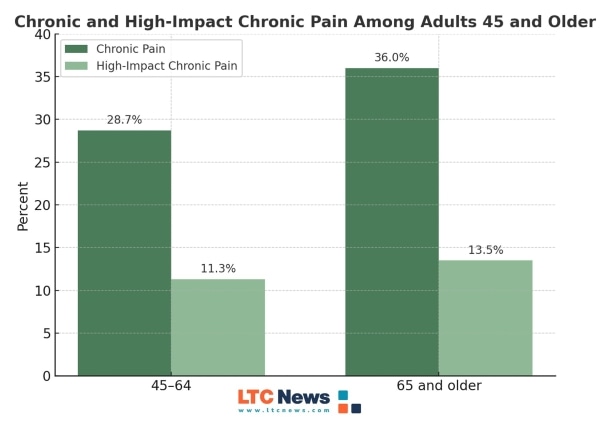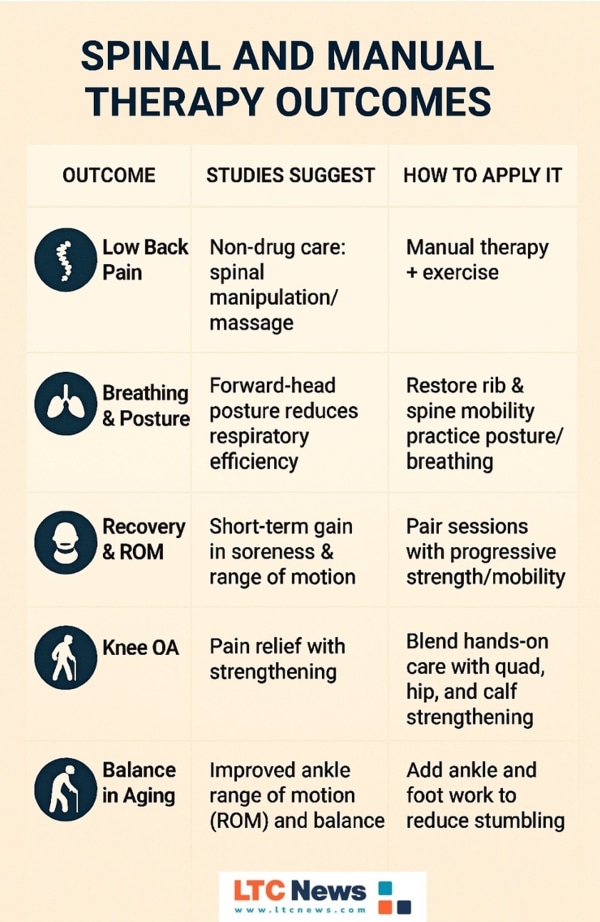Top 5 Reasons to See a Manual Therapist as You Age to Ease Pain

You know your body better than anyone. After 40, you probably start to feel new aches after yard work or a long drive. Tight hips. A stiff neck from screens. Soreness that steals sleep. Over time, pain and limited motion can snowball into bigger problems that affect how you work, exercise, and enjoy family life. After you retire, issues related to aging can aggravate these problems. Manual therapy can help you break that cycle.
Manual therapy is an evidence-based, hands-on approach used by licensed clinicians to assess joints, muscles, and connective tissue, then apply specific techniques to restore movement and reduce pain. It’s often paired with exercise and education for lasting results.
Prestige Health and Wellness states that clinics staffed by chiropractors, physical therapists, occupational therapists, and acupuncturists will diagnose and treat pain in most areas of the body as part of a comprehensive treatment plan.
What is Manual Therapy
“Manual therapy” is an umbrella term that’s often referred to by several other names, depending on the practitioner's training and credentials. Here’s how it’s described across different fields:
Common Alternative Terms
- Manual Physical Therapy – The most recognized term in clinical and rehabilitation settings. It refers to hands-on techniques used by physical therapists (PTs) to restore joint and soft tissue mobility.
- Orthopedic Manual Therapy (OMT) – A subspecialty within physical therapy focused on musculoskeletal disorders, emphasizing evidence-based assessment and joint or soft-tissue mobilization.
- Osteopathic Manipulative Treatment (OMT) – Performed by Doctors of Osteopathic Medicine (DOs), this term is specific to osteopathic medicine but falls under the same broader manual therapy umbrella.
- Chiropractic Manipulation / Spinal Manipulative Therapy (SMT) – Used primarily by chiropractors, focusing on spinal alignment and joint mobility to relieve pain and improve nervous system function.
- Myofascial Therapy or Soft Tissue Mobilization – Targeted toward the fascia and muscle layers to reduce tightness and improve flexibility.
How They Differ
While all of these approaches involve hands-on, movement-based care, the key differences are:
- Scope and regulation: Physical therapists, chiropractors, and osteopathic physicians operate under different state laws and licensure requirements.
- Clinical focus: Some emphasize muscle and soft tissue (PT, massage therapists), others target joint function or the spine (chiropractors, DOs).
- Terminology: The term “manual therapy” serves as a neutral, evidence-based term encompassing all these techniques without implying a specific professional discipline.
Manual therapy is not a miracle cure. The research shows real benefits for common problems when it’s done by qualified providers and combined with smart self-care.
What Manual Therapy Includes
Licensed professionals may use:
- Joint mobilization or manipulation to restore motion in stiff joints.
- Soft-tissue techniques, such as myofascial release and trigger point therapy, help reduce tightness.
- Targeted stretching and passive movements to improve flexibility and comfort.
These methods are part of a comprehensive plan that also incorporates exercise and patient education.
1) Relief From Chronic Pain
The CDC says that chronic pain affects nearly 1 in 4 U.S. adults and rises with age. It disrupts sleep, limits activity, and can lead to depression or anxiety.
Chronic pain and pain that limits daily life or work, known as high-impact chronic pain, are among the leading reasons adults seek medical care. Both are linked to reduced quality of life, higher rates of opioid misuse, increased anxiety and depression, significant unmet mental health needs, and increased need for help with daily living activities.

Clinical guidelines recommend starting with non-drug options for common pain, such as low back pain, including massage and spinal manipulation performed by trained clinicians. These approaches can reduce pain and improve function while lowering reliance on medications.
What this means for you: Manual therapy can target the source of stiffness and pain patterns, then pair it with exercises you can do at home.
2) Improved Posture and Easier Breathing
Hours at a desk and phone use pull the head forward and round the shoulders. That posture is linked with reduced lung function and altered chest mechanics. Improving alignment can make breathing feel easier and reduce neck and shoulder strain.
Studies show forward-head posture is associated with lower respiratory volumes and less efficient breathing mechanics. Restoring mobility in the spine and ribs, plus cueing better posture, can help.
What this means for you: Regular manual therapy, plus a simple desk setup and posture drills, supports a taller, easier breath and less daily fatigue.
3) Better Recovery and Performance
Whether you’re a weekend golfer or love long walks, recovery matters. Manual therapy can help reduce delayed-onset muscle soreness (DOMS) and improve range of motion, supporting steadier workouts and fewer overuse flare-ups. Evidence is strongest for short-term benefits, with best results when combined with exercise.
What this means for you: Use manual therapy to keep tissues moving, then lock in gains with strength and mobility work.
4) Lower Stress and Clearer Focus
Stress tightens shoulders and shallow breathing. Touch-based care, including massage therapy, shows benefits for pain, anxiety, and depression for some conditions, though the quality of evidence varies. Reviews also suggest manual therapies may modulate the autonomic nervous system, supporting the body’s “rest and digest” state.
What this means for you: A session can act like a reset. You feel looser, sleep better, and think more clearly when the body isn’t braced against pain.
5) Investing In Longevity and Independence
Small restrictions today can become bigger limitations later. In older adults, targeted manual therapy has been shown to improve ankle mobility and balance in randomized controlled trials. For knee osteoarthritis, systematic reviews report pain relief when manual therapy is used with strengthening exercise. These results suggest that staying active and independent for longer is beneficial.
What this means for you: Regular tune-ups help preserve joint motion, reduce compensations, and support confidence with daily tasks.

How Often Should You Go?
Frequency depends on your goals and health history. A typical plan is weekly visits for a short period, then taper as you build strength and self-management. Discuss with your healthcare professional the milestones that indicate it’s time to space out your visits.
Guidelines consistently emphasize combining manual therapy with exercise and education.
Choosing A Qualified Manual Therapist
Look for a professional who is licensed and trained to treat your specific condition:
- Physical therapist (PT or DPT) with manual therapy training.
- Doctor of Osteopathic Medicine (DO) using osteopathic manipulative treatment.
- Chiropractor offering spinal manipulation within evidence-based care plans.
- Licensed massage therapist working in coordination with your medical team for pain and stress support.
Ask about their plan to combine hands-on care with exercise, posture, and home strategies. Evidence supports multimodal treatment. “Multimodal treatment” refers to the use of multiple therapeutic approaches or methods to address a health issue, rather than relying solely on a single method.
Safety First
Manual therapy is generally safe when performed by a trained provider. Tell your provider about osteoporosis, cancer treatment, blood thinners, recent surgery, or a history of blood clots. Some vigorous techniques may need to be modified or avoided.
Seek urgent care for red-flag symptoms like sudden severe pain, loss of bladder or bowel control, chest pain, or unexplained weakness.
Role of Manual Therapy in Long-Term Care
As adults age or experience chronic illness, mobility loss, stiffness, and pain become major threats to their independence. Manual therapy helps counter these issues by improving movement, easing discomfort, and maintaining function, all critical for quality of life.
Common uses include:
- Restoring mobility after falls, fractures, or joint replacements.
- Reducing stiffness from arthritis, Parkinson’s disease, or prolonged sitting.
- Easing muscle tension caused by immobility or neurological conditions.
- Supporting posture and balance to prevent further injury or falls.
- Managing pain in residents who may not tolerate strong medications.
Every treatment plan must follow a physician’s order and fit within the resident’s care goals, often coordinated through Medicare Part A (post-acute rehab) or Part B (ongoing therapy).
Why It Matters
Manual therapy in long-term care isn’t just about pain relief — it’s about preserving independence and reducing reliance on nursing support. Improved mobility and posture can make it easier for residents in a long-term care facility to:
- Transfer safely from bed to chair,
- Walk to meals or activities,
- Breathe more deeply (better posture aids respiration), and
- Sleep with less pain and tension.
These small gains often prevent hospital readmissions and delay decline.
Insurance And Costs
Health insurance and Medicare coverage vary depending on the plan. Some insurers cover manual therapy under physical therapy or chiropractic services with a diagnosis and referral. For anyone living in a long-term care facility, these services can be covered by Medicare, but a majority of the cost of the extended care is not covered unless the care recipient has Long-Term Care Insurance.
Learn More: The Basics of Long-Term Care Insurance
Keep in mind that LTC Insurance is usually purchased when someone is between the ages of 47 and 67 as part of retirement planning. A licensed and qualified Long-Term Care Insurance specialist can help provide you with accurate quotes from all the top-rated insurance companies offering long-term care solutions.
Ask your provider and insurer before starting a series of visits.
Frequently Asked Questions
Q: Is manual therapy the same as massage?
A: Not exactly. Massage focuses on relaxation and circulation. Manual therapy is a clinical approach that also assesses and treats joint and soft-tissue dysfunction, often integrated with exercise and education.
Q: Can manual therapy replace medication?
A: For many common musculoskeletal problems, guidelines support trying non-drug options first. Your clinician may still recommend medications or other treatments based on your condition.
Q: Is there proof that it helps with stress?
A: Massage shows benefits for pain and anxiety for some groups, though evidence quality varies. Many people report better sleep and less tension after sessions.
Q: Is it safe for osteoporosis?
A: Yes, with modifications. Your team will avoid forceful techniques and focus on safe mobility and strengthening. Always inform your provider about bone density issues.
Your Next Step
If pain, stiffness, or changes in posture are holding you back, consider a trial of manual therapy with a licensed clinician who develops a personalized plan tailored to your goals. Pair hands-on care with strengthening and posture work for durable results.


